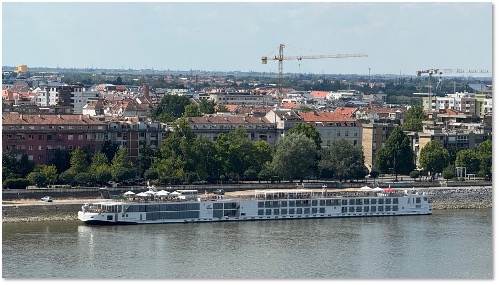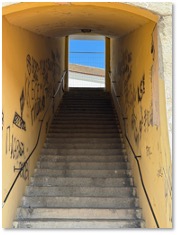We just completed a three-week vacation in the Balkan countries via Viking River Cruises. It was a terrific trip and one that I began somewhat less recovered from ankle surgery than I had been hoping. It meant traveling with a disability.
I took my cane and a fabric ankle brace to help me through long walks and difficult terrain like cobblestone streets. By the second week, I had mostly abandoned the cane but continued to use the brace for support. I carried plenty of Tylenol.
While I anticipated some difficulties, what I didn’t expect to find was a lack of accommodation in almost all of these countries for people who have a disability, people who need help with mobility, for one reason or another.
Why was I surprised?
The Americans with Disabilities Act
Because here in the United States, we have had something called the Americans with Disabilities Act for the past 35 years. The ADA prohibits discrimination based on disability. Uder Title III of the act,
“…no individual may be discriminated against on the basis of disability with regards to the full and equal enjoyment of the goods, services, or facilities or accommodations of any place of public accommodation.”
One can become accustomed to many things in 35 years and I have grown used to accessibility in public places. I expect others have, too.
If you have never needed this accessibility, count yourself lucky. Disability doesn’t apply just to folks born with a problem or suffering from a pernicious disease. Anyone, regardless of how young, strong or healthy, can break a bone, incur a sports injury, or contract an ailment. Just ask any professional athlete who makes a wrong move during a game and unexpectedly starts the long, hard road to recovery.
An Abrupt Introduction
My introduction to Europe’s different perspective came in Brasov, Romania. We went into the small art museum next door to our hotel and paid the fee. After cruising through two rooms of a special exhibit, we wanted to see the museum’s permanent collection. Which was on what we call the second floor but Europeans call the first floor. Which was located up a curving flight of stairs.
I was wearing my brace but preferred not to stress out the healing joint by climbing stairs. We asked for the location of the elevator and were met with disbelieving expressions. No, elevator. Nope. Stairs only. There are the stairs. Climb them or leave without seeing what you paid to see.
I took a deep breath and climbed the stairs. It took an effort but I made it. Later I added it to my life list of art museums I have visited around the world.
No Medieval Stairs for My Disability
Two days later we visited Bran Castle in Transylvania. Our guide warned us that the medieval castle was (a) largely empty and (b) extremely vertical with many stairs. We climbed up the stone ramp to the entry and saw a steep staircase that was very crowded. There were five people on every step waiting for several minutes to take the next step. I imagined that crowd inside the castle and decided to wait outside.
That was okay. One doesn’t expect an elevator in a medieval castle that had functioned as a military facility and then decides accordingly. It was not the only castle or fortress I bailed on. Other, more modern experiences followed, however.
Modern Stairs Are No Help
From airports to subway stations, I faced stairs. And more stairs. Whether steep or shallow, wide or narrow, large or small, they usually provided sole access to a building. The stairs also lacked railings of any kind. The wall (or my husband) provided stability—when there was a wall.
The broad flight of stairs leading into Budapest’s Museum of Fine Arts, for example, was daunting. From the bottom they don’t look so frightening. From the top, however, with a wonky ankle, they appear endless. There is, however, an iron fence at the bottom to catch you if you fall.
Relief for a Disability in Vienna
Not until we reached Vienna did I encounter the kind of accessibility the ADA provides to Americans.
At a concert in the Wiener Borsensale I and several others were able to use an elevator to bypass a steep flight of stairs that looked like it went all the way to heaven. It required an operator, however and we had to take turns because the elevator was so small.
The Kunst Historisches art museum in Vienna went a step further and provided a self-operating elevator to get from one massive floor to another. What a relief.
Sympathy for the Sick and Old
After a while, I began to feel sorry for the residents of Romania, Bulgaria, Serbia, Slovakia, Croatia, and Hungary, who have to get by as best they can with no assistance. Old people, injured people, and sick people get no help from the state or the architects. They also seem to get very little recognition, much less sympathy.
I guess this is only to be expected in countries that were for so long part of the Soviet Union. Human rights and a concern for individual human dignity have never been part of the Communist philosophy.
Still, it has been a while since the USSR broke up in 1991. Thirty-four years provides some time for adjustment.
Ice and the Disability
The good news is that I made it past these obstacles and had a wonderful trip despite them. When faced with slowing down the group or doing something else, I did something else.
Should you be contemplating such a vacation with a mobility-impairing condition, bring several Ziploc™ bags with you. I could always get ice on our Viking Longship and it’s usually readily available in hotels as well. Plastic bags are not. With them, you can ice the injury.
Also, watch out for cobblestone streets, old shiny-worn stone steps, and grates. Better safe than sorry.
The Airport Wheelchair
My best advice is to use a wheelchair to get through airports with their endless concourses. To do this, go to the airline’s website and fill out the forms with dates, flight number, etc.
When you get to the airport, ask for your wheelchair. It may not be there, but it will come. The operators will not only make it possible for you to avoid thousands of painful steps, they will zip past lines, take shortcuts, get you right to the front of a line, and whiz you through customs. Really.
In the Frankfurt airport, we would not have made our connecting flight without a wheelchair operator who knew where to go and how to get there fastest.
Tip the wheelchair operators well. They make a huge difference.




